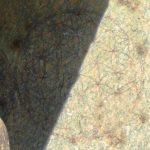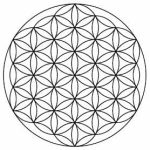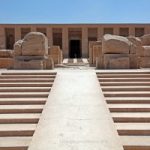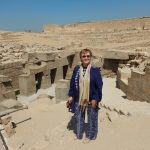This is Part 5 of the seven-part series, The Seeker’s Path. Begin the pilgrimage from the beginning here.
I believe that beyond the visible and tangible, we can tap into profound spiritual powers. My fascination with Egypt’s monuments is rooted in this alternative side—the romance, the enigma, the promise of secrets whispering just beyond hearing.
The Ceiling’s Unanswerable Question
Nothing whispers more insistently than the astonishing carvings often called the “helicopter,” “submarine,” “plane,” and “stealth fighter” on a ceiling beam in the Temple of Seti I. To find them, you must crane your neck in a dusty shaft of light near the temple’s roof, where the air hangs still and thick with the scent of stone and time.
The prevailing academic explanation is a palimpsest—a chance overlap of carvings where plaster and older hieroglyphs have eroded, creating a random, composite shape.
Yet, the precision of the lines and the coherence of the forms feel anything but random. Researchers like Jiri Mruzek have meticulously argued that the probability of such perfectly recognizable modern machines emerging from chaos is astronomically low. But their true power isn’t in proving a theory; it’s in their function. They are Abydos’s first and most effective question: a 3,000-year-old “WAKE UP!” that forces even the most skeptical soul to wonder, “What? Who? When?”
This is the essence of Sety I’s temple at Abydos. It is not merely a temple of worship, but a precision-engineered machine of stone designed to provoke awe and inquiry. This is the work of The Maker’s Hand.
Beyond Da Vinci: Tapping into a Universal Source
The brilliance of a mind like Leonardo da Vinci hints at a profound connection. While his notebooks reveal a genius rooted in empirical observation, they also point to a re-discovery of universal principles—sacred geometry, harmonic ratios—that the ancient Egyptians seem to have mastered millennia before. Da Vinci didn’t need an Egyptian scroll; he needed only to look at the same immutable laws of the universe that they encoded in stone. It makes you wonder if both he and the ancient builders weren’t just listening to the same quiet, powerful whisper of the universe
The Osirion: A Hidden Library of Stone
Nowhere is this genius more apparent than in the sunken, enigmatic Osirion. For decades, the famed Flower of Life symbols could only be glimpsed from the rim, their flawless, interlocking circles a tantalizing mystery on the colossal granite pillars.
That changed with private access. Inside the Osirion, the air is cool and heavy with the weight of millennia. The silence there is not an absence of sound, but a presence—a low hum of subterranean water and centuries pressing in on you. From this new vantage point, the temple reveals a deeper layer of its secrets. The walls, unseeable from above, have many light, intricate carvings and symbols—a hidden library of stone only legible to those who stand within its heart. You are not looking at a photograph or a theory; you are enveloped by the reality of it.
A Two-Part Masterpiece of Engineering
To truly grasp the genius at Abydos, you have to understand how it was built.
The entire complex is founded upon a single, massive geological shelf; the Temple of Seti I and the Osirion are perfectly aligned and carved from this same living rock, a feat of staggering foresight. The Temple of Sety is higher than ground level and the roof of the Osirion would have been at ground level!
You can see by putting the following two photos side by side – how high up the temple of Sety I is and in contrast how low down the ground at the back of that temple is – and moreover the Osirion is below that lower ground level
First, the ancient builders found a massive shelf of sandstone and carved the Osirion’s huge open court directly down into it, like digging the world’s most precise swimming pool out of solid rock. This sunken foundation anchors the entire structure.
Then, inside this carved shell, they constructed the interior with stone so precise it defies logic. The famous pillars aren’t just stone; each is a single, multi-ton block of red granite, quarried over a thousand kilometers away in Aswan. The walls are made of enormous blocks fitted together with a jigsaw-like precision that you see in places like the Valley Temple at Giza—some blocks are shaped with multiple angles to lock perfectly around corners. This has led many to believe that the Osirion is older than the main temple of Sety I.
So there are two parts: one part is carved from the earth, and one part of it is built with impossible masonry. This hybrid vision shows a frighteningly advanced understanding of geology, engineering, and design. This isn’t just stacking stones; it’s a level of planning and skill that remains stunning today.
The astonishing truth seems to be that Sety I was the architect of both the main temple AND the Osirion – and even more astonishing, the construction means that the ancient Egyptians had an uncanny way of knowing the depth and width of the underlying sandstone BEFORE moving a single stone.
👉 Explore all my transformative travel stories from Egypt
Ritual, Symbolism, and the Silent Message
The rituals that once animated this sacred space are not speculation. They are meticulously detailed in a fragile hieratic papyrus (British Museum EA 10673) discovered nearby. This ancient liturgical guide describes the Osiris Passion Play—the symbolic death and resurrection rites performed in the Osirion, transforming the structure and what is referred to as the “sarcophagus chamber” from mere stone into a living portal for spiritual rebirth.
This purpose is echoed throughout the main temple. As you pass into the long hypostyle hall, you encounter what history books will tell you are seven shrines dedicated to deities and the deified Pharaoh Seti I.
But to the seeker, standing in the hushed half-light, they present a deeper enigma. Why are the doorways to these shrines false, sealed in stone? Are they thresholds to the afterlife, gateways to other realms, or perhaps veils between the mortal and the divine? Their silent message seems to be: “Do not take everything at face value—here, or in life. The true entrance is not physical, but spiritual.”
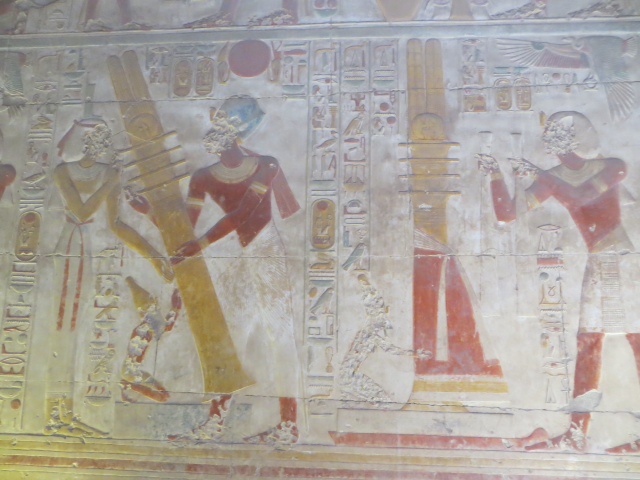
This journey culminates in the long room. Interestingly, there is access to it from only one of the 7 chapels. Here you will find the finest preserved depiction of the “Raising of the Djed.” This is not mere art. It is a frozen moment of spiritual technology—a ritual of stability, resurrection, and the eternal renewal of life, representing the very backbone of Osiris. It is the cosmological climax of the entire temple’s journey.
The Key Was Never Meant to Be Held
So, what are we to make of this place? What does all this mean for us? The palimpsest glyphs that ask unanswerable questions, the geometry carved with machine-like precision, the hybrid temple both born from and built upon the earth?
This is the true Key of Revelation: Abydos is not a puzzle to be solved, but a state to be experienced. The unseen genius—The Maker’s Hand—was not employed for boastful display. Every perfectly fitted block, every axis aligned to the bedrock, every symbol placed with intention was to create a resonant chamber for the soul. The precision is the means, not the end. The end was always connection with the essence of things.
The temple’s design is a precise technology for altering consciousness. With Dendera it is the heart chakra of Egypt. One is masculine. One is feminine. Perfect balance. Abydos is a machine built of stone, designed to guide the initiate through the layers of the self. The key was never meant to be held in your hand; it was meant to be felt in your bones. This is what it has to do with you.
The Seeker’s Path: TheSevenKeys – Abydos & Dendera
This article is part of a series. Unlock the full story with all seven keys.
- Key of Invitation: The Seeker’s Path
- Key of Connection: How the Stones Found Me
- Key of Devotion: Omm Sety – Dorothy Eady & Pharaoh Sety I
- Key of Mystery: Return of the Djedi?
- Key of Revelation: The Maker’s Hand – Unseen Genius at Abydos
- Key of Ritual: Beyond the Cartouches – The Priests Who Kept the Heartbeat of Abydos
- Key of Cosmos: The Celestial Secrets of Dendera Temple


